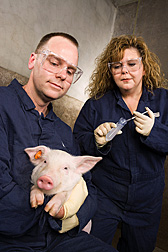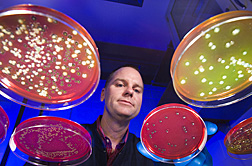Bacterial Backtalk
Swine, Stress, and Salmonella Infection
|
|
The complex cellular signaling that takes place between bacteria and host is called “crosstalk.” In animal production environments, this system is effective—and disruptive to animal health and food safety. So ARS microbiologists Brad and Shawn Bearson are looking for ways to cut off the communication.
The husband-and-wife team is learning how to interpret the crosstalk between swine and the foodborne pathogen Salmonella enterica serovar Typhimurium (S. Typhimurium). Brad works at the ARS National Soil Tilth Laboratory in Ames, Iowa, while Shawn is located across town at the ARS National Animal Disease Center.
The researchers studied how S. Typhimurium responds when it is exposed to norepinephrine, a hormonal neurotransmitter that helps animals regulate their physiological response to stress. As part of this regulation, norepinephrine secretion increases when stress levels increase—a situation swine commonly face during transport.
Microbe on the Move
The researchers found that S. Typhimurium is able to respond to norepinephrine via a two-component system involved in monitoring the bacterial environment. This phenomenon is called “microbial endocrinology.” An adaptation that mirrors similar systems in E. coli and other pathogens, it enhances the pathogen’s potential for motility (movement) and colonization.
|
|
One component—a protein called “QseC”—is embedded in S. Typhimurium’s membrane. When norepinephrine increases, QseC alerts a response regulator called “QseB” inside the bacterial cell. QseB responds to this alert by regulating a cascade of early, middle, and late genes that increase the pathogen’s motility.
Although multiple two-component sensing-and-signaling systems are present in bacterial cells, this is the first time that the response of QseC to norepinephrine has been characterized in S. Typhimurium. In addition, this is the first time it has been described in a large-animal model.
“Performing experiments in a large-animal model is important,” Shawn notes, “because in the small-animal model—the mouse—S. Typhimurium infection is systemic. But when pigs are infected with S. Typhimurium, they don’t usually develop systemic infections; instead, they develop gastrointestinal (GI) tract infections. So the large-animal model is much more applicable to food safety and livestock health—and maybe to human health as well.”
To learn more about how QseC supports S. Typhimurium in the swine GI tract, the researchers developed a strain of S. Typhimurium with a genetic mutation that inactivated the qseC gene. This mutation, in turn, inactivated the QseC protein. They inoculated 13-week-old pigs with both the mutant strain and a wild-type S. Typhimurium strain. After 1 week, they took samples of GI tract tissue from the inoculated swine and examined the samples for bacterial colonization.
The researchers found that the wild-type strain was able to establish significantly more colonies in the swine GI tract than the mutant strain.
Bearson and Bearson also found that swine inoculated with the mutant bacterium shed significantly fewer pathogens. This has potential food safety consequences, because even asymptomatic pigs can carry and shed S. Typhimurium, which can then infect other swine around them.
“All of our results indicate that QseC regulates a variety of genes that affect pathogen motility, fitness, and invasive effectiveness,” Brad says. “Just as important, our results show that this two-component sensing system is a key factor in the ability of S. Typhimurium to successfully colonize the swine GI tract.”
Secrets to Success
Once the researchers had a clearer understanding of how S. Typhimurium responds to fluctuating norephinephrine levels, they began to look for a medication that could disrupt the response. They decided that phentolamine—a compound already used medicinally in humans—was a likely candidate for in vitro testing.
In these studies, the scientists exposed wild-type S. Typhimurium to either norepinephrine or a combination of norepinephrine and phentolamine. They observed that phentolamine eliminated the pathogen’s norepinephrine-enhanced motility.
But S. Typhimurium’s success in swine isn’t just due to its increased motility when norepinephrine levels increase. It also has a mechanism for acquiring iron from its host to support its own growth and replication.
In blood serum, a protein called “transferrin” binds to iron. This binding action blocks efforts by opportunistic bacteria to use the metal for their own survival and reproduction.
But norepinephrine can also bind to iron. When this occurs, S. Typhimurium has receptors that bind to the norepinephrine, which allows the pathogen to access the sequestered iron. On the other hand, too much iron can be toxic, and S. Typhimurium has developed genetic mechanisms to regulate iron acquisition and uptake.
The researchers identified key S. Typhimurium genes involved in the pathogen’s ability to access iron from norepinephrine. They also found 36 genes involved in the bacterium’s iron response that were down-regulated when exposed to norepinephrine, protecting the pathogen from iron toxicity.
The team is pleased with their results to date. But they still have key questions about how these findings can enhance food safety and livestock health.
“We’re still dealing with significant unknowns,” Shawn cautions. “We don’t know how much norepinephrine increases in the GI tract during stress, so we can’t pinpoint the levels that might require intervention and treatment.”
“We also want to find out differences between S. Typhimurium and E. coli to exploit for targeted interventions against Salmonella,” Brad says. “We’re going to start in vivo studies of phentolamine, and we’re going to keep looking for other substances that interfere with S. Typhimurium colonization of the GI tract. We want to find a proven method for inhibiting the pathogen before the pigs even begin to experience stress.”—By Ann Perry, Agricultural Research Service Information Staff.
This research is part of Food Safety, an ARS national program (#108) described on the World Wide Web at www.nps.ars.usda.gov.
Bradley L. Bearson is in the USDA-ARS Swine Odor and Manure Management Research Unit, 2110 University Blvd., Ames, IA 50011; phone (515) 294-0209, fax (515) 294-1209.
Shawn M.D. Bearson is in the USDA-ARS Pre-Harvest Food Safety and Enteric Diseases Research Unit, 2300 Dayton Ave., Ames, IA 50010; phone (515) 663-7455, fax (515) 663-7458.
"Bacterial Backtalk: Swine, Stress, and Salmonella Infection" was published in the August 2009 issue of Agricultural Research magazine.








